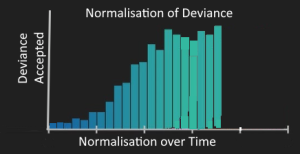Normalisation of Deviance
The pernicious growth of the Normalisation of Deviance within the Moreton Bay Regional Council is shown graphically.

With each candidate Development Application lodged, there is likely to be some components that are non-conforming with adopted Planning Scheme Policy.
Lodging town planners and Council Assessors have become comfortable in describing these non-conforming components as “generally in accordance with” and “is generally compliant with” Policy.
Where components are clearly not closely compliant, nor generally compliant, they omit any reference to those parts.
This has developed into the adoption of Normalisation of Deviance.
The Stages of Normalisation
The deviation from Policy has many driving forces.
These range from the Real Estate Agents, Property Owners/Developers, Commercial Planning Entities, Council Planning Officers. The driving force in each is driven by financial gain or workplace recognition.
The Real Estate Agents work toward achieving sales by promoting properties as candidates for possible planning policy exemptions or exceedances. They will infer planning approvals based upon other local planning approvals that deviate from policy.
The Property Owners/Developers seek to maximise their financial position by pushing for policy exemptions and exceedances such that they can build more economically.
The Commercial Planning Entities profit from having development applications proposed by Developers approved. They encourage Council decision makers to approve by skirting deviances from policy whilst focussing on aspects where an application meets, or generally meets policy. They use obfuscation and omission as they see fit.
The Council Planning Officers are the final spoke in the wheel when it comes to normalisation of deviance.
They will be guided toward granting approvals that deviate from policy based upon one or more earlier decisions. Each subsequent approval supports the preceding deviations from policy thus building on the acceptance and normalisation of deviance.
The normalisation of deviance process is self sustaining and should be identified as early as possible with protections put in place and the practice halted.
This phenomenon becomes recurring when people within an organization become so insensitive to deviant practice that it no longer feels wrong.
Insensitivity occurs insidiously and sometimes over years because the practices are not called-out.
Failing to have close regard to Policy statements are deviances from evidence-based practice and the officially adopted policy.
Deviation occurs because of barriers to following Policy correctly or drivers such as time, cost, and peer pressure.
Operators will often adamantly defend their decisions and actions as necessary and justified.